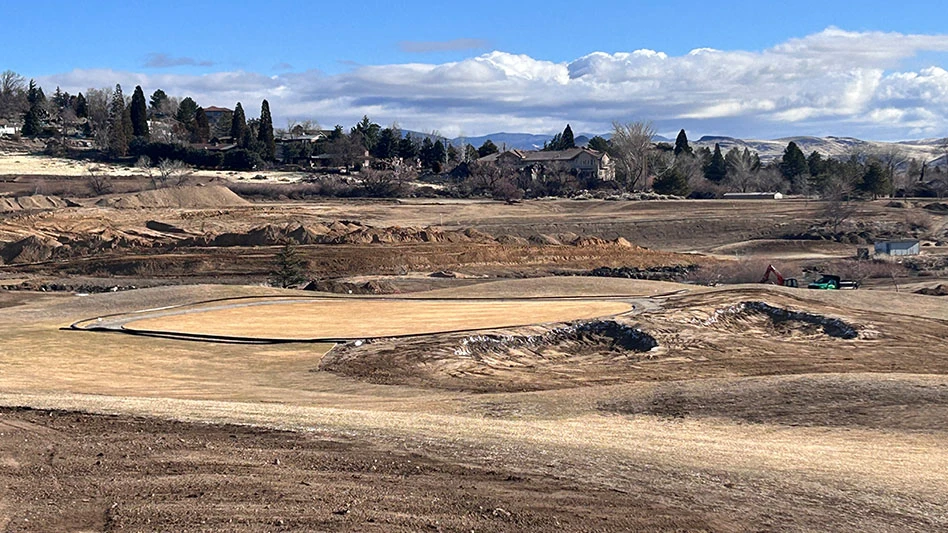Recently, I was asked a simple question that has a complicated answer: “How did you decide to put a bunker there?” While it seems intuitive, there’s a logical thought process.
I usually have a target number of bunkers based on course type or construction and maintenance costs. Within those parameters, I view potential bunker locations in terms of natural land forms and the ability to serve multiple functions. Then I consider aesthetics, variety and maintenance. The process is repeated.
Land forms
Golfers should see the hazards affecting play. Attractive bunkers are great visual design elements, so why hide them? Achieving visibility requires bunkers to slope toward a golfer’s view, so a natural bunker location is one where the natural upward slope faces the golfer. Building up the ground for bunkers is possible on flat or even reverse-sloped ground; but they rarely look as good or natural as ones cut into an existing slope, so I build most of my bunkers where slopes naturally provide visibility with minimal earthwork.
Greens built into hillsides usually result in bunker-friendly slopes on the low side, as well as the high side in some cases. Building greens on raised fill pads on flat sites usually creates good bunker slopes, providing the green shape allows the bunkers to partially face the fairway for visibility. I rarely put bunkers behind moderately elevated fill-pad greens or any green built on a reverse slope because those backing bunkers rarely catch shots, limiting their usefulness.
Usefulness
Many aesthetic but out-of-play bunkers have been removed from golf courses and should continue to be removed, especially given the increased standards and bunker maintenance costs. Generally, fewer bunkers are being built compared to a decade ago because fewer courses can afford numerous or random bunkers built purely for aesthetics. In most cases, bunkers should affect play directly and provide aesthetics, safety, drainage and environmental protection. Where multiple opportunities don’t exist or where water, specimen trees or unique contours exist, I won’t use bunkers. I’ll save them for areas devoid of natural features to create similar play interest.
Strategy
Hazards should create strategy for good players by placing green and fairway bunkers that relate shots to each other. Following a classic strategic design, fairway and green bunkers are placed on opposite sides of a hole, encouraging players to flirt with fairway bunkers to open the green on the approach. Good strategies can be developed using different bunker relationships, so finding a design that works using mostly natural bunker locations isn’t too difficult.
Rather than follow the tried-and-true method of bunker left/bunker right, I prefer mixing bunkers with other hazards to make golfers think about where to miss, while offering a variety of recovery shots suited to differently skilled players.
Bunkers usually are more visually dominant than grass hazards, and I use them where I want visual stop signs, intimidation through size or depth, or distance perception.
Difficulty and speed of play
Once an architect was told club members had difficulty getting out of the bunkers he designed on their course. The architect apparently didn’t consider the difficulty and speed-of-play issues most courses face.
Challenge and difficulty are distinct. Feathering a six-iron fade to a tucked pin technically is the same challenge whether the bunker is two- or 20-feet deep. Fortunately, bunkers don’t need to be excessively deep. While some contend short approach shots suggest deeper bunkers proportionally punish missed shots, most prefer all greenside bunkers to be shallow enough to see the pin.
Similarly, locating hazards in areas frequented only by average golfers – specifically slice side sand bunkers short of the green – also slows play. Leftside bunkers should outnumber rightside bunkers considerably.
Aesthetics and psychology
If artistically arranged and well located, bunkers frame holes and greens, act as directional devices and lead the eye. Bunkers built without proper support, behind trees or on a hill are partially hidden and less attractive and shouldn’t be built. Bunkers visually covering the fairway or green often make holes feel less comfortable while slowing play. Why force bunkers in where they don’t fit?
Generally, small spaces require small bunkers or a consideration of other hazards. Single bunkers usually need attractive or dramatic shaping. Where room permits, bunker clusters are attractive and different if they’re randomly spaced.
Variety
Golf holes look too much alike more often than they look too different, often because of the notion that similar bunkers create a theme.
Bunkers should have a style, but within that style I favor creating visual variety by varying bunkers in number, size, pattern and placement. I purposely design some fairways and greens without bunkers and others with several. I alternate from lightly to heavily bunkered holes. If the construction budget or course type demands it, several greens or fairways will have one bunker only. I strive for variety, combining sand with other types of hazards.
Review and repeat
The short version of the bunker design process is:
1. Decide how many you want.
2. Find natural landforms that cry out for bunkers. Make the most of those.
3. Find areas where bunkers serve strategic, aesthetic and other useful purposes.
4. Use less natural but workable areas to create man-made variety.
5. Avoid using indifferent locations that cause excessive difficulty, maintenance problems or slow play.
6. In special cases, ignore rules one, three, four and five.
7. Review the plan and tweak it to assure the course has bunkers and they won’t cause excessive difficulty or slow play.
I repeat steps two through six several times until, paraphrasing Charles Blair Macdonald, “I am confident they are perfect and beyond criticism.” But that never happens.
Architects have lower “batting averages” than Major League Baseball players when it comes to bunkers, as more courses have redesigned bunkers throughout time than not. Because bunkers generate so much debate and discussion, they have survived golf’s migration from their natural environs of the Scottish links land to remain a staple of golf course design. GCN

Explore the November 2006 Issue
Check out more from this issue and find your next story to read.
Latest from Golf Course Industry
- The Cabot Collection announces move into course management
- Carolinas GCSA raises nearly $300,000 for research
- Advanced Turf Solutions’ Scott Lund expands role
- South Carolina’s Tidewater Golf Club completes renovation project
- SePRO to host webinar on plant growth regulators
- Turfco introduces riding applicator
- From the publisher’s pen: The golf guilt trip
- Bob Farren lands Carolinas GCSA highest honor







